Physical Address
304 North Cardinal St.
Dorchester Center, MA 02124
Follicular lymphoma (FL) is defined in fourth edition of the WHO Classification of Tumours of Haematopoietic and Lymphoid Tissues as a neoplasm composed of follicle center (germinal center) B cells (typically both centrocytes and centroblasts) that usually has at least a partially follicular pattern. If diffuse areas of any size composed predominantly or entirely of blastic cells are present in any case of FL, a diagnosis of diffuse large B-cell lymphoma (DLBCL) is also made. Lymphomas composed of centrocytes and centroblasts with an entirely diffuse pattern in the sampled tissue may be included in the category of FL. Primary cutaneous lymphomas of germinal center cells are considered a distinct category: primary cutaneous follicle-center lymphoma. The major features of FL are listed in Table 18-1 . Several FL variants that have distinctive clinicopathologic features are defined in the WHO classification ( Box 18-1 ).
| Feature | Description |
|---|---|
| Definition | A lymphoma of germinal center B cells (centrocytes and centroblasts) with typically at least a partially follicular pattern |
| Frequency | 40% of adult lymphomas in the United States; 20% worldwide |
| Age | Median, 55-59 years |
| Sex | Male = female |
| Clinical features at presentation | Generalized lymphadenopathy, frequent splenomegaly, often asymptomatic; bone marrow positive in 40%; rare stage I, extranodal or pediatric |
| Morphology |
|
| Usual Immunophenotype | Ig + , CD19 + , CD20 + , CD22 + , CD79a + , PAX5 + , CD10 + , BCL2 + , BCL6 + , CD43 − , CD5 − ; nodular meshworks of CD21 + , CD23 + follicular dendritic cells |
| Genetic features | Immunoglobulin genes rearranged, mutated, intraclonal heterogeneity; t(14;18)(q23;q32) and IGH/ BCL2 rearranged |
| Postulated normal counterpart | Germinal-center B cells |
| Clinical course | Indolent, incurable: median survival 8-10 years; prognosis based on histologic grade (grade 1 to 2 indolent, grade 3 aggressive), Follicular Lymphoma International Prognostic Index |
| Treatment | Symptomatic for grade 1 to 2, aggressive for grade 3 |
In situ follicular neoplasia
Duodenal-type follicular lymphoma
Extranodal follicular lymphoma
Follicular lymphoma with predominantly diffuse growth pattern and 1p36 deletion
Follicular lymphoma with mutations of NOTCH1 or NOTCH2
Pediatric-type follicular lymphoma
Large B-cell lymphoma with IRF4 translocation
FL affects predominantly adults, with a median age of 55 to 59 years (see Table 18-1 ). In contrast to most other hematologic malignancies, it is equally common in women and men. In the United States, it is two to three times more common in whites than in blacks. It occasionally occurs in individuals younger than 20 years; pediatric patients are predominantly boys with FL localized to the head and neck, including the tonsils (see the section on variants of follicular lymphoma later in the chapter). FL is the second most common lymphoma worldwide (after DLBCL), accounting for 20% of all non-Hodgkin's lymphomas. It constitutes almost 40% of non-Hodgkin's lymphomas in the United States and up to 70% of “low-grade” lymphomas reported in American clinical trials. It is less common in other parts of the world, including eastern and southern Europe, Asia, and non-industrialized countries : 28% to 33% of lymphomas in the United States, Canada, London, and Capetown, South Africa, but only 17% to 18% in Germany and France, 11% in Ticino, Switzerland, and 8% in Hong Kong.
The incidence of FL in the United States in the past 20 years has been estimated at 2.7 to 3.0 per 100,000 for white men and women and 0.9 to 1.3 per 100,000 for black men and women. The annual incidence of FL in Asian countries has been estimated at 0.15 to 0.38 per 100,000—less than 10% that in industrialized Western countries.
Ethnic susceptibilities have not been extensively evaluated and are difficult to dissect from socioeconomic factors. In one report from Malaysia, FL accounted for only 12% of 158 adult non-Hodgkin's lymphomas; lymphomas in Indian patients were more likely to be follicular (31%) than they were in Malaysian (16%) or Chinese (6%) patients. In a study of Chinese and Japanese residents of the United States, the relative risk for FL was low among those born in Asia (relative risk 0.11 to 0.15 compared with white Americans) and higher among those born in America (relative risk 0.36 to 0.84), suggesting that environmental factors may be more important than race.
Most patients with FL have widespread nodal disease at the time of diagnosis, even though they may feel relatively well. In most studies, up to two thirds of patients are in stage III or IV. They infrequently have systemic “B” symptoms (28%); 44% are in the low-risk group (category 0/1) of the Follicular Lymphoma International Prognostic Index (FLIPI), and 48% are in the low-intermediate–risk group (category 2/3).
Peripheral, mediastinal, and retroperitoneal nodes are often involved. Large mediastinal masses are rare, but large retroperitoneal and mesenteric masses often occur and may cause ureteral obstruction. Pure extranodal presentations are uncommon—9% in one survey —and extranodal involvement (other than bone marrow) was seen in 20% of cases in another study. The most common sites of stage IV disease are the bone marrow and liver, with 42% of patients having bone marrow involvement. The majority of patients probably have circulating neoplastic cells, and a small proportion are frankly leukemic.
Non-nodal presentations usually involve the spleen, Waldeyer's ring, skin, or gastrointestinal tract. Within the gastrointestinal tract, the small bowel and particularly the duodenum are most often involved (see the section on variants of follicular lymphoma later in the chapter). Rare cases of FL presenting as lymphomatous polyposis of the intestinal tract have been reported. Primary cutaneous lymphoma of the follicle-center type is an important subset of cutaneous B-cell lymphoma and is discussed in Chapter 20 .
The diagnosis of FL is best made on an excisional lymph node biopsy, which provides the best opportunity to assess grade and pattern. Patients with peripheral lymph nodes that are accessible for open biopsy should have this procedure done. For patients with deeper, less accessible lymph nodes, FL can be diagnosed on fine-needle aspiration or core needle biopsy if adequate material is available for morphologic evaluation and for immunophenotyping (flow cytometry or immunohistochemistry) to document clonality and confirm germinal-center origin Distinction between grade 1 or 2 and grade 3 FL may not be possible with these specimens, and in such cases, excision may be considered. In addition, grade 3B cases may not be distinguishable from DLBCL, but this distinction may not be clinically relevant.
Patients typically undergo abdominal and pelvic computed tomography scanning and bone marrow biopsy for staging, as well as measurement of serum lactate dehydrogenase for stratification within the FLIPI.
The centrocytes and centroblasts of most cases of FL are morphologically similar to those of normal germinal centers ( Fig. 18-1, A-F ). The nuclei of centrocytes (see Fig. 18-1, C, D ) are usually less than twice the size of small lymphocytes, but they may be almost as large as the nuclei of tissue histiocytes or centroblasts. The nuclei appear irregular or angulated in tissue sections; although the term cleaved is used, a distinct nuclear cleft is seldom seen in tissue sections. The chromatin is paler than that of small lymphocytes and is evenly dispersed, giving the nucleus a gray-blue appearance. One or more small nucleoli may be present. The cytoplasm is scant and pale and is usually not visible on hematoxylin-eosin–stained or Giemsa-stained sections. In most cases, the centrocytes appear more monomorphous than those of normal follicles, with the majority being approximately the same size. The nuclei of centroblasts (see Fig. 18-1, B, D-F ) are usually three to four times the size of small lymphocytes, similar to or larger than the nuclei of tissue histiocytes; the nuclei are round or oval but may be irregular, indented, or even have a cleft. The nucleus is vesicular, with a clear center and some peripheral condensation of chromatin; there are one to three basophilic nucleoli, often apposed to the nuclear membrane. Centroblasts have a narrow rim of cytoplasm that is intensely basophilic on Giemsa staining. The proportion of centroblasts may vary somewhat among follicles in a given case; an extreme example is shown in Figure 18-1, G . Areas of diffuse large B-cell lymphoma may be encountered in FL of any grade (see Fig. 18-1, H ). In cases with ill-defined neoplastic follicles, an immunostain for follicular dendritic cells can be useful to distinguish follicular and diffuse areas (see Fig. 18-1, I ).
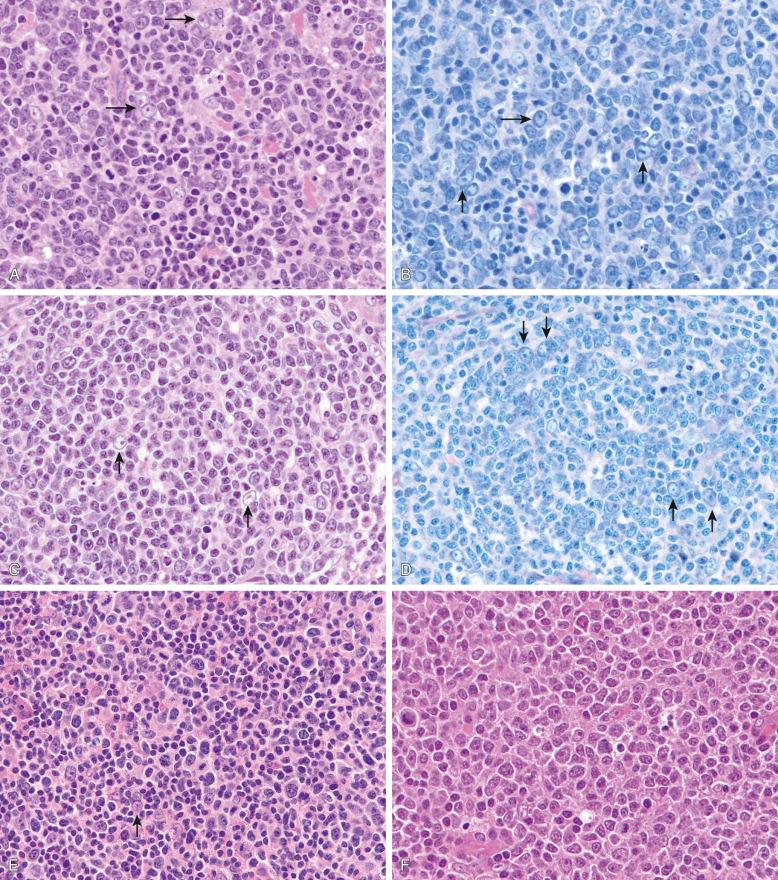
In most cases of FL, the centrocytes are relatively small, and the few centroblasts stand out sharply against the monotonous background of centrocytes. In some cases, however, the centrocytes are larger and may be almost as large as centroblasts. In these cases, the centrocytes may appear more pleomorphic, with more deeply indented or multilobated-appearing nuclei. Centroblasts may also appear atypical, with a variable nuclear size and shape, increased heterochromatin, and binucleate or multinucleated forms.
Mitotic activity is low in most cases of FL, and a “starry sky” pattern, with phagocytic histiocytes, is rare. However, in cases with increased numbers of centroblasts, mitoses are more numerous and, rarely, phagocytosis of nuclear debris may be seen. Polarization, as seen in reactive follicles, is rare in FL, although in some cases centroblasts may be more numerous in one area of the follicle than another, creating an impression of polarization.
In addition to clonal B cells, neoplastic follicles contain follicular dendritic cells (FDCs); their nuclei are similar in size to centroblast nuclei, but they have delicate nuclear membranes and central, small, eosinophilic nucleoli. FDCs are often binucleate, and the two nuclei are typically apposed to each other, with flattening of the adjacent nuclear membranes (see Fig. 18-1, C, E ). In contrast to centroblasts, their cytoplasm does not stain blue with Giemsa stain. Small T cells are also present in neoplastic follicles; these are usually less numerous than in reactive germinal centers, but occasionally they may be very numerous.
FL rarely contains an appreciable number of plasma cells, which can be useful in its differentiation from reactive hyperplasia; however, a small proportion of follicular lymphomas have variably extensive plasmacytic differentiation ( Fig. 18-2 ). Follicular lymphoma of any grade may have plasmacytic differentiation, although it appears to be present more often in higher-grade follicular lymphomas. The plasma cells may be found predominantly in the interfollicular area, in an intrafollicular or perifollicular distribution, or in a combination of these patterns. The appearance of the plasma cells ranges from small and mature to somewhat atypical. Some plasma cells may contain Dutcher bodies, nuclear pseudoinclusions of cytoplasm containing immunoglobulin. In rare cases of FL, the neoplastic centrocytes have large cytoplasmic vacuoles, either clear or eosinophilic, giving them the appearance of signet ring cells ( Fig. 18-3, A ). In most of these cases, cytoplasmic immunoglobulin can be demonstrated in the signet ring cells. Cases with clear cytoplasm typically express cytoplasmic immunoglobulin (Ig)G, with a predominance of lambda light chain, whereas those with periodic acid–Schiff–positive eosinophilic globules in the cytoplasm or nucleus more commonly express IgM. On ultrastructural examination, the clear inclusions are large, often membrane-bound vacuoles containing multiple tiny, coated vesicles, whereas the eosinophilic inclusions consist of dilated rough endoplasmic reticulum filled with electron-dense material, presumably immunoglobulin. Clinically, FL with a signet ring cell morphology does not differ from typical FL. Most cases are classified as grade 1 or 2.
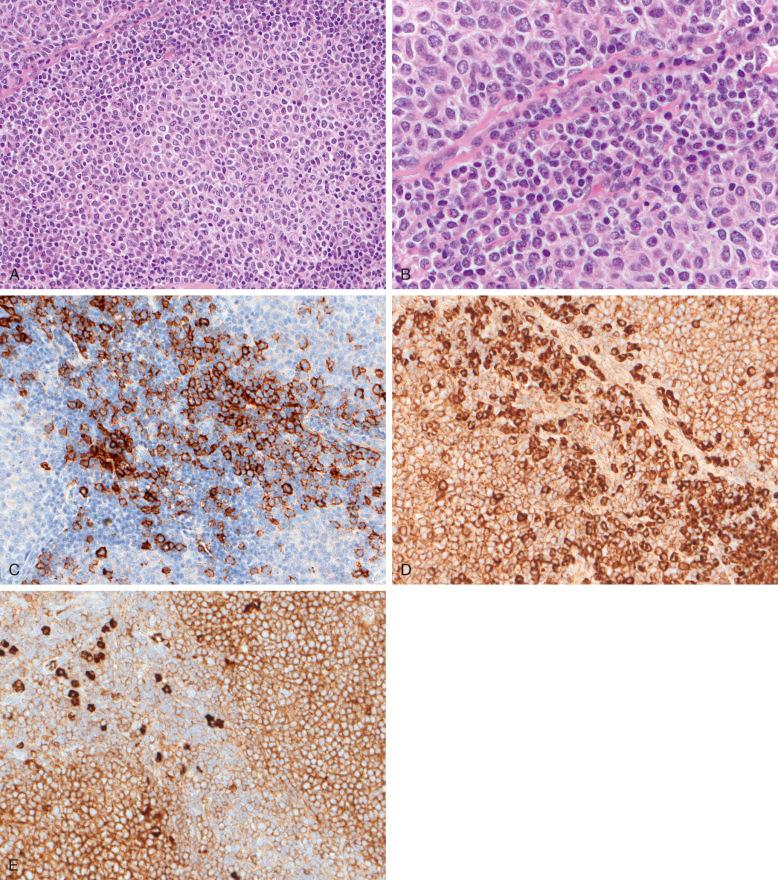
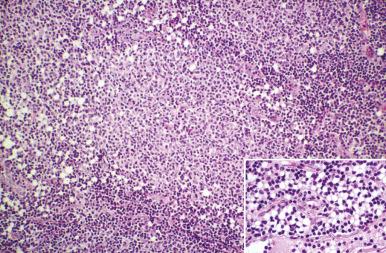
FLs have variable numbers of centroblasts, and the clinical aggressiveness of the lymphoma increases with the number of centroblasts. It has repeatedly been shown that an individual pathologist can effectively predict outcome in FL by grading according to the proportion of large cells, but this is difficult to reproduce among groups of pathologists. Several studies have suggested that the “cell counting” method of Mann and Berard is more reproducible and better at predicting prognosis than other methods of grading FL. In this method, the centroblasts (large nucleolated cells) per 40 microscopic high-power field (hpf) are counted (10 to 20 hpf in different randomly selected follicles 40×). A case with up to 5 centroblasts/hpf is grade 1; 6 to 15 centroblasts is grade 2; and greater than 15 centroblasts is grade 3 (see Fig. 18-1, C-F ). Using a standard 0.159 mm 2 hpf, the international study of the Revised European American Lymphoma (REAL) classification found that a cutoff of 15 centroblasts/hpf significantly predicted overall and disease-free survival in FL. Approximately 80% of FLs are grade 1 (40% to 60%) or grade 2 (25% to 35%). Because there is no appreciable difference in clinical behavior between grades 1 and 2, the WHO classification now combines them into a “low-grade” category ( Table 18-2 ).
| Grade | Definition |
|---|---|
| Grade 1 to 2 (low grade) * | 0-15 centroblasts/hpf † |
| Grade 1 | 0-5 centroblasts/hpf † |
| Grade 2 | 6-15 centroblasts/hpf † |
| Grade 3 | >15 centroblasts/hpf † |
| Grade 3A | Centrocytes present |
| Grade 3B | Solid sheets of centroblasts |
| Reporting of Pattern | Proportion Follicular (%) |
| Follicular | >75 |
| Follicular and diffuse | 25-75 ‡ |
| Focally follicular | <25 ‡ |
| Diffuse | 0 § |
| Diffuse areas containing >15 centroblasts/hpf are reported as diffuse large B-cell lymphoma ‡ with follicular lymphoma (grade 1 to 2, 3A, or 3B) | |
* Cases of grade 1 to 2 follicular lymphoma with a proliferation fraction >40% may be reported as “follicular lymphoma grade 1 to 2 with a high proliferation fraction.”
† hpf, high-power field of 0.159 mm 2 (40× objective). If using an 18-mm field-of-view ocular, count 10 hpf and divide by 10; if using a 20-mm field-of-view ocular, count 8 hpf; if using a 22-mm field-of-view ocular, count 7 hpf for an equivalent area and divide by 10 to get the number of centroblasts/0.159 mm 2 hpf.
‡ Give approximate percentages in report.
§ If the biopsy specimen is small, a note should be added that the absence of follicles may reflect sampling error.
With these numerical cutoffs, the spectrum of grade 3 FL ranges from cases with 16 large cells/hpf to those in which the majority of cells in the follicle are centroblasts. Some studies suggest that cases with solid sheets of centroblasts are biologically distinct from those with a mixture of centrocytes and centroblasts. For this reason, the WHO classification recommends subdividing grade 3 FL: grade 3A, with more than 15 centroblasts/hpf, but centrocytes are still present; and grade 3B, with solid sheets of centroblasts (see Fig. 18-1, E-G ). Grade 3B cases are often associated with areas of DLBCL. Differences in genetic features and clinical behavior have led to the suggestion that grade 3A FL may be more indolent and genetically more closely related to low-grade FL, whereas grade 3B cases are more closely related to DLBCL. However, these studies have typically included cases of grade 3B FL with DLBCL. One study found that although grade 3B FL had a distinctive gene-expression profile, it was closer to that of grades 1 to 3A FL than to that of DLBCL. Thus, all grades are currently still classified as FL. Infrequently FL is composed predominantly of large centrocytes (large cleaved cells). Grading of such cases is controversial. According to the WHO classification, such cases would still be considered low grade (grade 1 to 2 of 3) ; others, however, have reported that FL, large cleaved-cell type, has a prognosis similar to that of FL grade 3, so assigning a designation of grade 3 to such cases may be more appropriate. Additional study is required to determine the optimal grading of such cases. The proliferation fraction using immunohistochemical staining for Ki-67 typically mirrors grade, with grade 1 to 2 cases having a proliferation fraction of less than 20%, and grade 3 greater than 30%. One study suggested that the Ki-67 fraction was less useful than the histologic grade in predicting outcome. Occasional histologically low-grade cases have a high proliferation fraction. In one study, patients with a high proliferation fraction (>40%) had a survival more similar to that of grade 3 FL than to typical grade 1 to 2 FL. Thus, the WHO suggests (but does not mandate) that Ki-67 staining be used as an adjunct to grading. The presence of a high Ki-67 fraction should not change the histologic grade; such cases are reported as “grade 1 to 2 with a high proliferation fraction,” with a note that this may portend a more aggressive course than suggested by the grade.
The relative proportion of centrocytes and centroblasts may vary from one follicle to another in a given case. Multiple sections must be examined, and the proportion of large cells is estimated based on a representative sample of follicles. Rarely, individual follicles or parts of the node may show an abrupt transition from a predominance of centrocytes (grade 1 to 2) to a predominance of centroblasts (grade 3) (see Fig. 18-1, G ). In such cases, it is appropriate to give the predominant grade (grade 1 to 2) with a separate diagnosis of grade 3 (A or B), giving the relative proportions of each.
Areas of DLBCL may also be found in lymph nodes showing FL (see Fig. 18-1, H ); this is more common in grade 3B cases but can occur in other grades. In such cases, the primary diagnosis should be DLBCL (see Table 18-2 ) with a secondary diagnosis of FL and an estimate of the proportion of each. Occasional patients with FL have divergent histologic features in lymph nodes taken simultaneously from different sites, showing a variation in grade or progression to DLBCL.
Lymph nodes are typically enlarged, with complete effacement of the architecture by neoplastic follicles. The follicles are typically uniform in size; are closely packed; lack a mantle zone, starry-sky pattern, and polarization; and are evenly distributed throughout the lymph node, obliterating sinuses and extending outside the capsule ( Fig. 18-4, A ). Neoplastic follicles may range in size from no larger than a primary follicle to much larger than the average reactive follicle; although usually round, they may be irregular and serpiginous (see Fig. 18-4, B ), mimicking floridly reactive hyperplastic follicles. Within a given tumor, the follicles are likely to be relatively uniform and monotonous, but in some cases there is marked variation in size from one follicle to another. In other cases, the follicles may appear irregularly mottled, with fragmented follicle centers; this usually occurs in cases with increased large cells and has been called the floral variant of FL (see Fig. 18-4, C ).
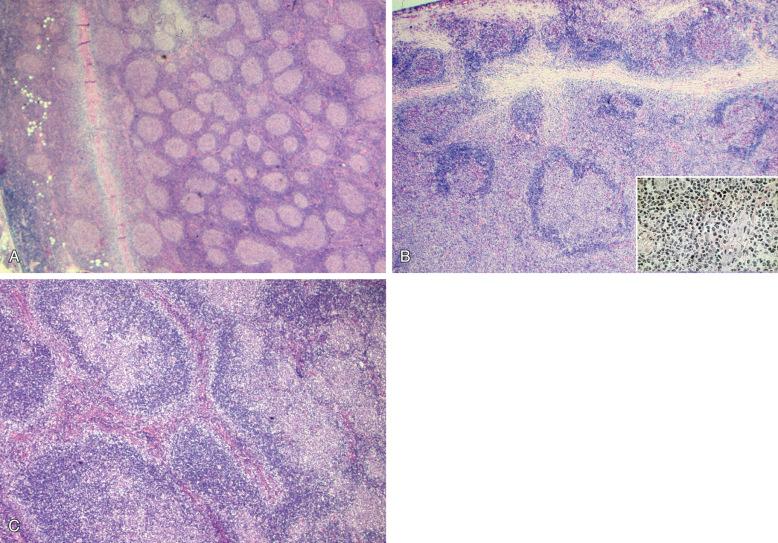
Neoplastic follicles usually lack mantle zones, but in some cases partial or complete mantle zones may be present around all or some of the follicles (see Fig. 18-4, B ). In some FLs, the outer cells of the follicles may resemble marginal-zone or monocytoid B cells, with nuclei similar to centrocytes but with more abundant, pale cytoplasm ( Fig. 18-5 ). These cells may form partial or complete marginal zones around some or most of the follicles in a given case, and they may have an interfollicular and perisinusoidal distribution, resembling nodal involvement by extranodal MALT-type marginal-zone lymphoma or nodal marginal-zone lymphoma. This phenomenon should not be regarded as a “composite lymphoma” with follicular and monocytoid B-cell lymphoma, as has been suggested by some authors ; rather, it should be considered evidence of intratumoral differentiation. Marginal-zone B cells in cases of FL with marginal-zone differentiation share the same genetic abnormalities as the neoplastic follicles. In one study, the presence of significant marginal-zone or monocytoid B-cell areas in FL was associated with a significantly worse prognosis compared with cases lacking this feature.
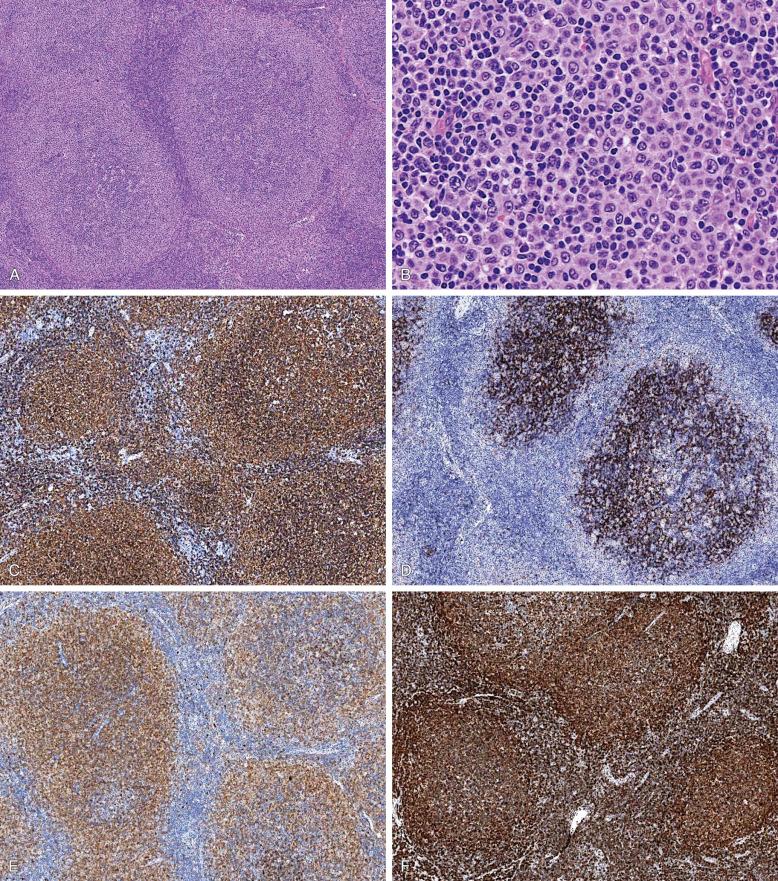
Subcapsular and medullary sinuses are typically obliterated, but sinuses may be partially or completely preserved. Extracapsular extension is common but not universal; when it occurs, the capsule may be visible as a band of fibrous tissue within the tumor. Successive levels of extracapsular extension may appear as concentric parallel bands of fibrosis in the extranodal tissue (see Fig. 18-4, A ). In most cases, the follicles are closely packed, with absence of the normal T zones. The interfollicular region may contain numerous small blood vessels of the high endothelial venule (HEV) type but is poor in transformed lymphocytes and plasma cells and usually contains neoplastic centrocytes. In occasional cases, interfollicular involvement is prominent, leading to widely spaced follicles (see Fig. 18-4, B ). This interfollicular involvement is not considered to constitute a diffuse area: a diffuse area is defined as an area completely lacking follicles.
Sclerosis is common and may be present surrounding the follicles, in diffuse areas, or, less often, within the follicles. It is more marked in areas where the infiltrate is diffuse, which can be a useful feature in distinguishing FL from follicular or diffuse lymphoid hyperplasia. In diffuse areas with sclerosis, the neoplastic centrocytes may be spindle-shaped, resembling fibroblasts ( Fig. 18-6, A ). Centrocytes are often more numerous in sclerotic areas than in other areas; thus, in difficult cases, careful examination of the cells in areas of sclerosis is useful in establishing the diagnosis.
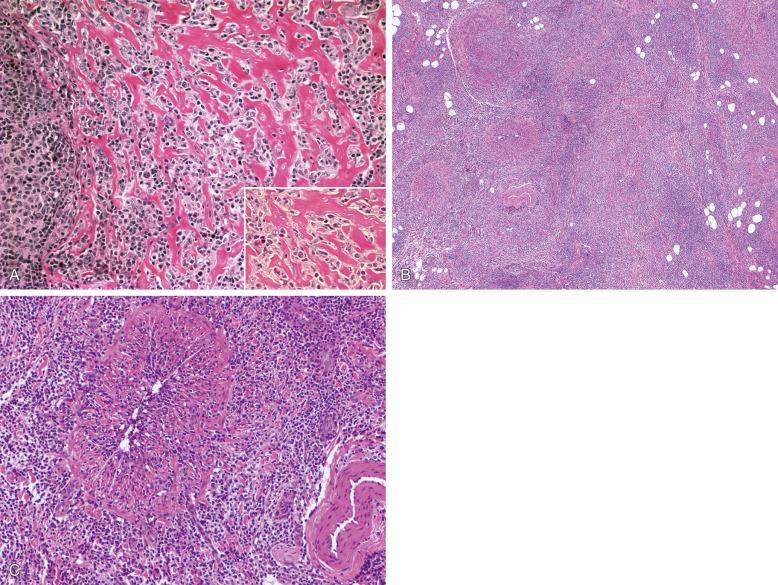
Occasional cases of FL may have amorphous, eosinophilic, extracellular, periodic acid–Schiff–positive material deposited in an irregular fashion within the follicle centers. The nature of this material is not clear; Chittal and colleagues found that ultrastructurally it contained membrane fragments, and on immunohistochemistry it contained many antigens found in and on the neoplastic cells (CD45, CD22, immunoglobulin). Others have speculated that it represents the deposition of antigen-antibody complexes on the processes of FDCs, analogous to the deposits often seen in reactive follicles. However, in reactive follicles, extracellular immunoglobulin deposition is rarely massive enough to be conspicuous by light microscopy, whereas in the few lymphomas that exhibit this phenomenon, it may be impressive. Thus, although uncommon and by no means diagnostic, massive extracellular deposition of amorphous material within follicles should raise the question of lymphoma.
Vascular invasion is surprisingly common in FL, both within involved lymph nodes and in pericapsular veins. Centrocytes infiltrate through the walls of small and even larger veins, accumulating within the intima (see Fig. 18-6, B, C ). Vascular invasion may be useful in distinguishing FL from hyperplasia. Perhaps as a consequence of this invasion, total infarction of the lymph node may occur. The diagnosis can be suspected in totally infarcted nodes by careful evaluation of the cells preserved in the extranodal tissue and by reticulin stains, which demonstrate the follicular pattern throughout the infarcted area; molecular genetic analysis can occasionally demonstrate immunoglobulin gene rearrangement in infarcted tissue, and immunohistochemistry may be used to document that the cells are CD45 positive and CD20 positive, although non-specific staining of necrotic tissue by these antibodies can be a problem.
A diffuse area in FL is defined as an area that lacks evidence of neoplastic follicles and contains a mixture of cells similar to that seen within the neoplastic follicles (see Fig. 18-6, A ). Involvement of the interfollicular region by neoplastic cells is not considered evidence of a diffuse pattern. Although the prognostic importance of diffuse areas is debatable, the WHO Clinical Advisory Committee recommends that they be quantified. The WHO classification therefore recognizes three categories of grade 1 to 2 FL, covering the most clinically important subgroups: follicular (>75% follicular), follicular and diffuse (25% to 75% follicular), predominantly diffuse (<25% follicular), and diffuse (0% follicular)(see Table 18-2 ). Diffuse areas in low-grade (grade 1 to 2) FL are not thought to be of prognostic significance; however, diffuse areas composed predominantly of centroblasts (grade 3) are diagnosed as DLBCL (see Table 18-2 ).
Rare lymphomas composed of both centrocytes and centroblasts have a purely diffuse pattern. In some of these cases, it is likely that focal follicular areas are present and that the purely diffuse pattern is the result of a sampling problem.
In the WHO classification, diffuse FL is defined as a diffuse lymphoma composed of both centrocytes and centroblasts in which centrocytes predominate (grade 1 to 2, low-grade). A diffuse lymphoma with a predominance of large follicle-center cells (>15 centroblasts/hpf; grade 3) should be classified as DLBCL.
The diagnosis of diffuse FL should be made with caution, after other diffuse lymphomas have been excluded and when sufficient tissue is available to exclude the presence of follicles. Immunophenotyping studies are essential to show that both small and large cells are B cells (to exclude T-cell–rich large B-cell lymphoma) and that the immunophenotype is consistent with FL (CD10 + , BCL6 + , BCL2 + , CD5 − , CD43 − , cyclin D1 − ). Molecular genetic or cytogenetic analysis for evidence of BCL2 rearrangement may be useful to confirm this diagnosis. However, cases of predominantly diffuse FL lacking BCL2 rearrangement, often with deletions at 1p36 and presentation at an early stage with large inguinal tumors, have been described and are discussed separately later in the chapter.
In some cases of FL, the nodal architecture may be largely or partially preserved, with residual reactive germinal centers; this phenomenon is reportedly associated with a lower stage at diagnosis. In other cases, there may be widely spaced monomorphous follicles surrounded by a relatively normal-appearing interfollicular region, without evidence of extrafollicular neoplastic cells ( Fig. 18-7 ). This pattern appears to reflect the homing of neoplastic cells to preexisting reactive follicles, with follicular colonization by tumor cells. This phenomenon may occur in lymph nodes with obvious FL elsewhere in the node, in adjacent nodes, or, rarely, in patients without evidence of overt lymphoma (see the section on in situ follicular neoplasia later in the chapter).
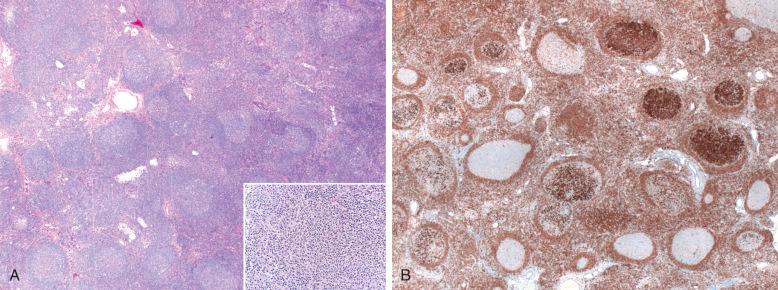
Splenic involvement by FL typically produces uniform enlargement of white pulp, resembling reactive hyperplasia both on gross examination and at low magnification. This phenomenon has been postulated to reflect the neoplastic cells' ability to “home” to normal B-cell regions ( Fig. 18-8, A ). The white pulp follicles in FL are increased in number as well as size and show a monomorphous infiltrate of centrocytes and centroblasts, similar to that in lymph nodes. The marginal zone may be preserved, making it difficult to differentiate FL from splenic marginal-zone lymphoma (see Fig. 18-8, B ). The red pulp typically contains numerous small follicles, but diffuse red pulp involvement is uncommon.
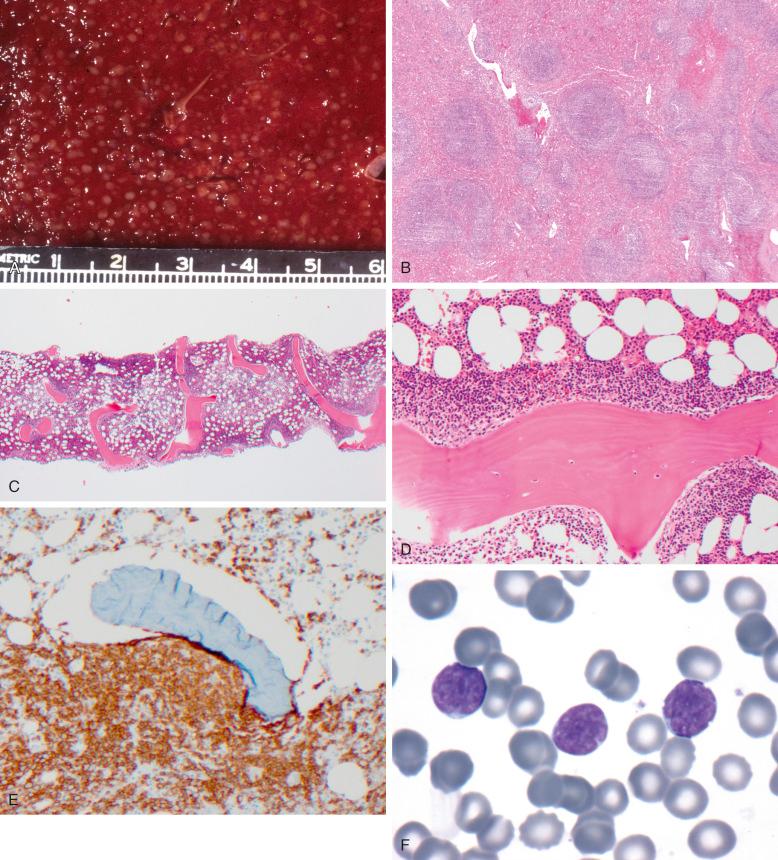
Bone marrow involvement by FL is seen as large, usually circumscribed nodules adjacent to bony trabeculae (see Fig. 18-8, C-E ). This feature is useful in distinguishing nodules of lymphoma from benign lymphoid aggregates, which are usually central within marrow spaces rather than paratrabecular; however, occasional paratrabecular lymphoid aggregates can be seen in apparently healthy individuals. Infiltrates that appear to hug or wrap around bony trabeculae are highly suspicious for FL, in contrast to those that simply touch the trabeculae. Marrow aggregates of FL are typically composed predominantly of small centrocytes (see Fig. 18-8, D ), with only rare centroblasts; the cellular composition may not reflect that of the lymph node, which may contain larger centrocytes and more centroblasts. Marrow involvement by identical cells can be seen in cases of diffuse large B-cell lymphoma—so-called discordant bone marrow histology. Thus, lymphomas cannot be accurately subclassified based on their appearance in the bone marrow because this may not reflect the appearance of a nodal tumor.
Most patients with FL have small numbers of circulating neoplastic cells without an elevated lymphocyte count, which can be detected by flow cytometry or molecular genetic analysis to detect the t(14;18) translocation. Rare patients with FL have an elevated lymphocyte count with circulating centrocytes, which are usually slightly larger than small lymphocytes and have a nuclear cleft (see Fig. 18-8, F ). Absolute lymphocyte count ranges from 1000 to more than 200,000/µL. FL patients presenting with a leukemic phase often have a high-risk FLIPI score (see the section on prognosis and predictive factors later in the chapter). Follicular lymphom a s with a leukemic phase appear to behave in a more aggressive manner than those without, with shorter progression-free and overall survival. The morphology of the circulating cells may be similar in follicular and mantle cell lymphoma, and some cleaved cells may be seen in occasional patients with chronic lymphocytic leukemia. Immunophenotyping by flow cytometry and often lymph node biopsy are typically necessary for correct subclassification.
Patients with FL may have a more aggressive B-cell lymphoma sometime during the course of their disease. The magnitude of this risk is difficult to assess because not all patients undergo repeat biopsy before repeat therapy. Studies have shown an actuarial risk for transformation of approximately 2% per year and 20% at 8 years. Transformation is usually to DLBCL ( Fig. 18-9, A, B ), most commonly with cells resembling centroblasts or immunoblasts but occasionally with anaplastic CD30-positive cells.
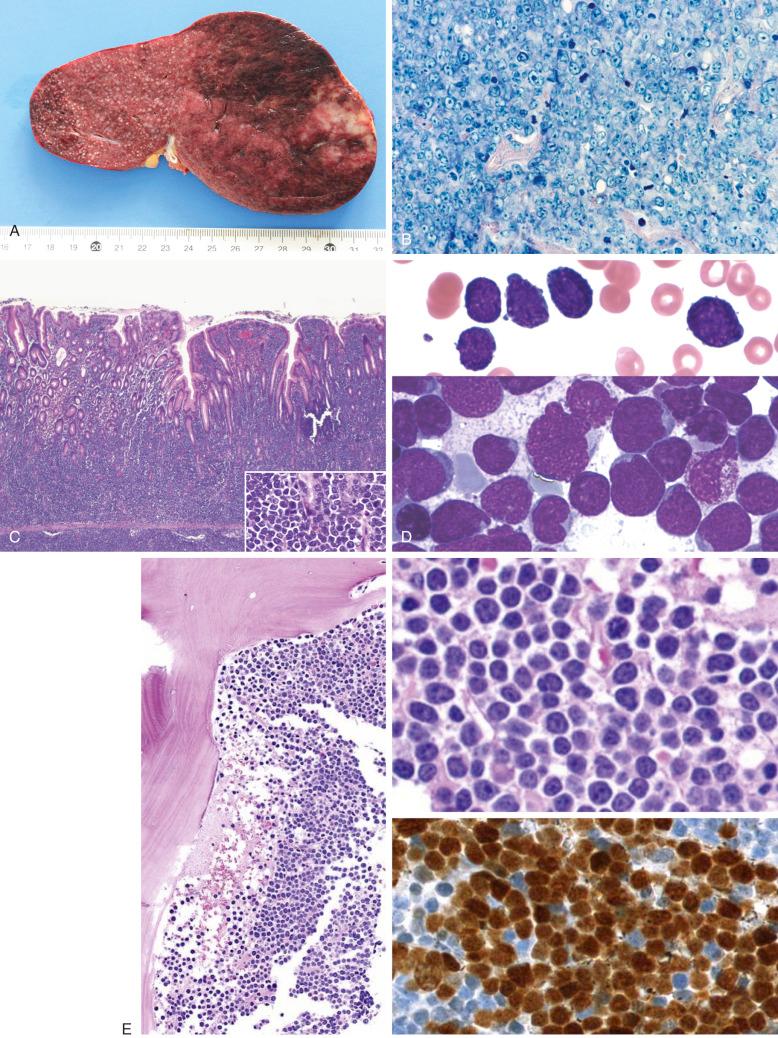
Cases of transformation to high-grade lymphoma resembling Burkitt's lymphoma (high-grade B-cell lymphoma, NOS) (see Fig. 18-9, C, D ) or B-lymphoblastic leukemia (see Fig. 18-9, E ) or lymphoma have been reported, both typically with acquisition of a translocation involving the MYC gene on chromosome 8 (“double hit”) (see Fig. 18-9, F, G ). The high-grade tumors are typically clonally related to the pre-existing FL. TP53 mutations as well as MYC gene rearrangement have been associated with transformation in FL.
FL may precede, follow, or occur simultaneously with Hodgkin's lymphoma. The occurrence of both Hodgkin's lymphoma and FL in the same tissue is relatively rare but may occur (see Fig. 18-9, H-J ). In two studies, single-cell analysis of neoplastic cells from the Hodgkin's lymphoma component and the FL component of composite or sequential lymphomas demonstrated identical immunoglobulin heavy-chain gene rearrangements in the two tumors; both showed somatic mutations, consistent with derivation from a common germinal-center cell precursor. Divergent patterns of somatic mutation indicated that the two tumors originated from a common precursor but diverged at the germinal center centroblast stage, with the FL continuing to acquire new somatic mutations.
Several cases of histiocytic-dendritic cell tumors in patients with a history of FL were reported in which identical IGH and BCL2 gene rearrangements were found in both tumors. Loss of PAX5 has been shown in animal models to result in dedifferentiation of B cells to precursors that can then differentiate into T cells or myeloid cells. This finding in a mature B-cell neoplasm suggests that neoplastic B cells may exhibit lineage plasticity and give rise to secondary non-lymphoid tumors.
FL B cells express pan–B-cell antigens (CD19, CD20, CD22, CD79a, PAX5) and surface immunoglobulin with light chain restriction. Flow cytometry is usually required to demonstrate immunoglobulin expression; occasionally it can be detected by immunohistochemistry ( Fig. 18-10, A-E ). In more than 50% of cases, the surface immunoglobulin is mu heavy chain, with a minority also expressing delta heavy chain; a large minority express gamma heavy chain, and rare cases express alpha heavy chain. The frequency of immunoglobulin heavy-chain class switching is higher in FL than in other low-grade lymphomas, consistent with the observation that immunoglobulin heavy-chain class switching normally occurs in the germinal center. Most cases express the germinal center–associated protein CD10 (see Fig. 18-10, F ); CD10 expression is often stronger in neoplastic follicles than in reactive germinal centers. FL also invariably expresses nuclear BCL6 protein in at least a proportion of the tumor cells. In normal germinal centers, virtually all cells are BCL6 positive, whereas a variable proportion of cells are BCL6 positive in FL (see Fig. 18-10, G ). Both CD10 and BCL6 may be downregulated in interfollicular neoplastic cells and in areas of marginal-zone differentiation (see Fig. 18-5, E ). A novel marker of germinal-center cells—GCET1, also known as centerin —was discovered by gene-expression analysis; it is consistently detected in FL and other lymphomas of germinal-center B-cell derivation. Other germinal-center cell markers expressed by most FL and useful in the differential diagnosis with other related lymphomas are LIM-only transcription factor 2 (LMO2) and human germinal-center–associated lymphoma (HGAL), also known as GCET2.
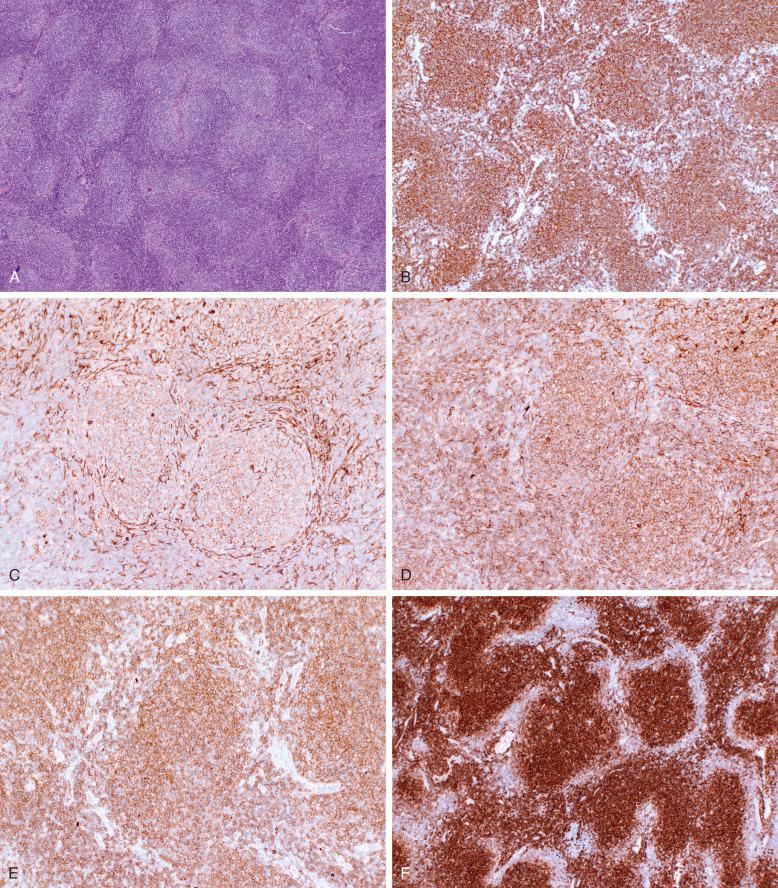
FL is typically CD5 negative and CD43 negative. Rare cases of CD5-positive FL have been reported. Most CD43-positive cases are grade 3 with areas of DLBCL. MUM1/IRF4 is typically not expressed, although occasional cases of grade 3 FL that lack CD10 and BCL2 and express MUM1/IRF4 have been reported. FL typically expresses the CD95/Fas protein. FL also expresses costimulatory molecules CD80, CD86, and CD40. Expression of these antigens is weak compared with that of normal germinal-center B cells.
About 75% of cases express the BCL2 protein (see Fig. 18-10, H ) ; the frequency is highest (85% to 97%) in grade 1 to 2 cases and as low as 50% to 75% in grade 3 cases. Expression of the BCL2 protein is highly predictive of the presence of a BCL2 translocation; however, some FL cases with BCL2 rearrangement have mutations in the BCL2 gene that affect detection of the protein by the commonly used antibody, resulting in a false-negative result (see Fig. 18-10, I ).
Neoplastic follicles contain many elements of the germinal-center microenvironment. Nodular aggregates of FDCs outline the neoplastic follicles, demonstrated by monoclonal antibodies to CD21 or CD23 (see Fig. 18-10, J ). Expression of CD21 and CD23 is variable, and some FLs may express one and not the other; thus, staining for both may be necessary. In diffuse areas of FL, FDCs are absent (see Fig. 18-1, I ); this may be useful in distinguishing diffuse FL from mantle-cell and marginal-zone lymphomas, in which large, irregular aggregates of FDCs are present even in areas that appear diffuse on routine staining. Neoplastic follicles also contain follicular-type T cells (positive for CD3, CD4, CD57, PD1, and CXCL13), which are usually less numerous in neoplastic than reactive follicles ( Fig. 18-10, K ) and are randomly distributed; this contrasts with the crescentic arrangement at the junction with the mantle zone that characterizes reactive follicles. Varying numbers of FoxP3-positive T-regulatory cells and CD68-positive histiocytes are present, and multiple studies have reported that the number and/or distribution of tumor-infiltrating T-regulatory cells, PD1-positive follicular T-helper cells, and CD68-positive macrophages predict clinical prognosis, although results are not uniform.
Most cases of low-grade FL have a proliferation fraction with Ki-67 of less than 20% (see Fig. 18-10, L ); however, rare cases have a high (>40%) proliferation fraction (see Fig. 18-10, M, N ) and may behave more like grade 3 FL (see the section on grading earlier in the chapter).
Become a Clinical Tree membership for Full access and enjoy Unlimited articles
If you are a member. Log in here